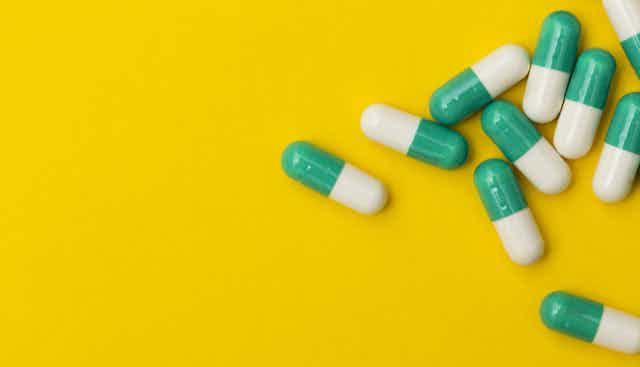Bacteria possess even more tools to protect themselves from antibiotics than previously thought, according to our latest research. The ability of microbes to avoid death at the hands of antibiotics is a worldwide concern. Our study illustrates how bacteria directly combat the presence of antibiotics using newly identified defence systems.
Rising numbers of antibiotic resistant bacteria are a major healthcare challenge. Antibiotics underpin modern medical, veterinary and farming practices worldwide. Scientists know that bacteria can mutate, rendering antibiotics less effective. Resistance genes – chunks of DNA that allow bacteria to avoid the effects of antibiotics – can also be passed around bacterial populations at an alarming rate.
Unless tackled, antibiotic resistance promises a future with rising healthcare costs, longer and more frequent hospital visits and a rising death toll. The World Health Organisation suggests that many medical advances of the last century will become useless if the issue of antibiotic resistance is not solved.
Fishing in the genome
At the University of Birmingham, we have been trying to understand how bacteria exploit their existing defence systems, rather than evolve mutations, to avoid the effects of antibiotics. Working with Escherichia coli, which can cause urinary and blood stream infections, we used experimental tools never previously applied in the area of antimicrobial resistance.
These experiments rely on whole-genome sequencing – a process whereby the sequence of all bacterial genes are “read” in full. However, a major problem is figuring out which genes are important for dealing with antibiotics; these genes represent less than 1% of all those within a genome sequence.
To identify the handful of genes involved in resistance to antibiotics, we went fishing in the genome sequence. Our tool of discovery was chromatin immunoprecipitation, an approach best imagined as a molecular fishing rod.
Using this method, we were able to “hook” genes involved in protection against different antibiotics. We were able to do this because these genes have a molecular signature that bound tightly to the “bait” at the end of our imagined fishing line. The bit of DNA that we hooked could then be sequenced and, by comparing it with all the genes in the genome, identified.
The genes that we found were then studied further using a range of experimental approaches. This included genetic manipulation of the bacteria to inactivate the genes. Once the genes were identified, the bacteria were challenged with different antibiotics. In doing so, we could work out if we had hit any “hot spots” within the genome for antibiotic resistance. It transpired that resistance to classes of antibiotics known as tetracyclines and quinolones was altered.

A new way to beat antibiotic resistance?
An important part of our work has also been trying to figure out exactly how the different genes were providing resistance. We discovered that one set of genes allowed bacteria to respond to the presence of antibiotics by modifying their cell surfaces. In particular, the amounts of molecules called lipids, which are present in the cell membrane, can be reduced. This makes it more difficult for antibiotics to penetrate bacterial cells. Importantly, this process required no mutation.
We also discovered that bacteria can avoid destruction of their DNA, caused by some antibiotics, if they “switch on” molecular machines that repair DNA damage.
All of the antibiotic resistance processes that we identified rely on a protein called the “multiple antibiotic resistance activator” that is found, in various forms, in many different types of bacteria. I hope that by understanding this protein we can find ways to sabotage defence systems that bacteria use to protect themselves from antibiotics. For example, it may be possible to develop drugs that, by blocking bacterial defence pathways, make existing antibiotics more useful.

